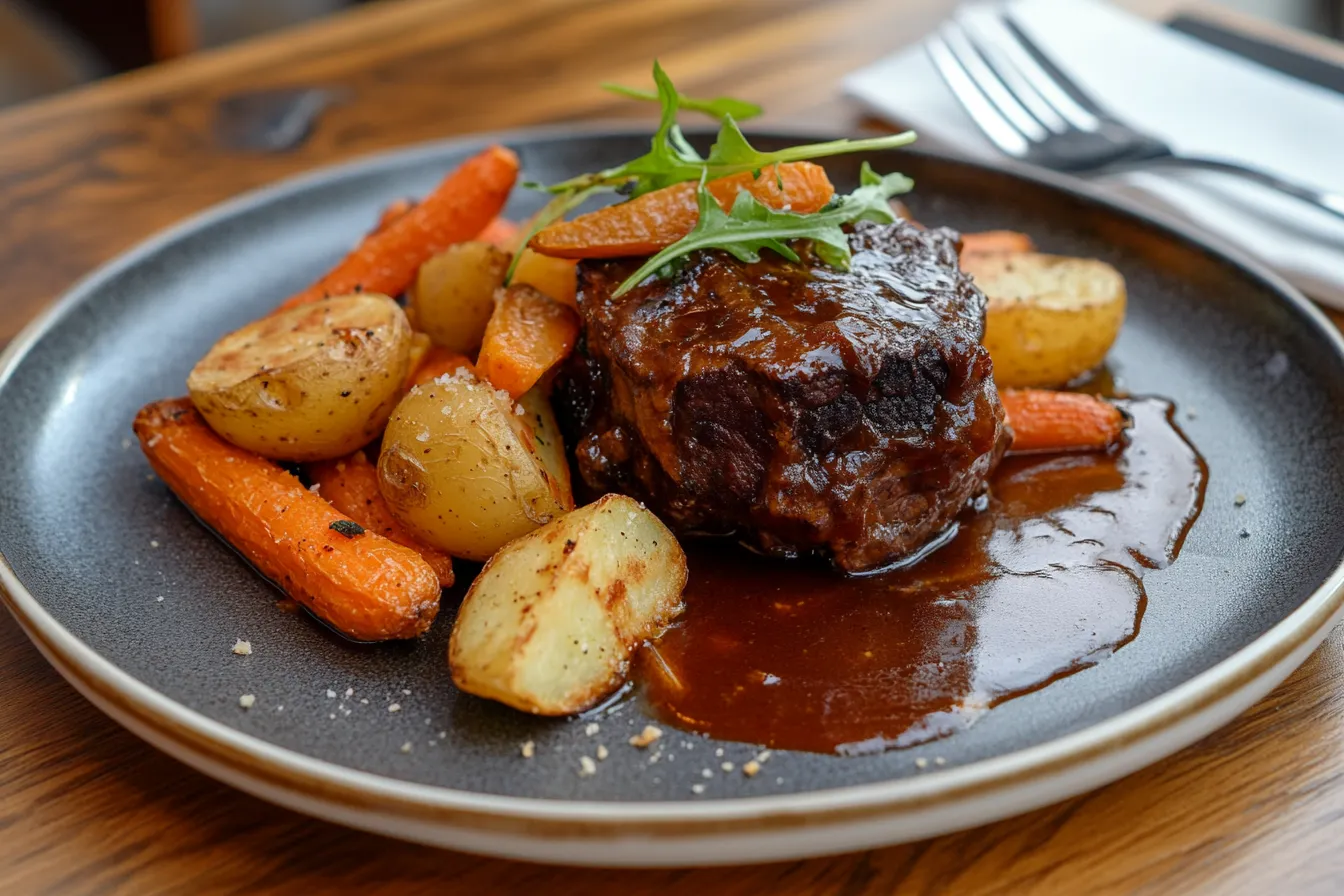Have you ever tried beef cheek meat? If not, you’re seriously missing out! This underrated cut of beef is packed with flavor and becomes incredibly tender when cooked properly. Whether you’re a home cook or a professional chef, beef cheeks deserve a place in your kitchen.
In this article, we’ll explore everything you need to know about beef cheek meat: what it is, its nutritional benefits, the best cooking methods, common mistakes, and even some mouthwatering recipes. Let’s dive in!
What is Beef Cheek Meat?
Beef cheek meat comes from the facial muscles of a cow. Since cows chew almost all day, their cheek muscles are constantly working, which results in a dense, tough cut of meat loaded with connective tissue and collagen.
Understanding the Cut: Location and Texture
Unlike steak cuts that are naturally tender, beef cheeks are tough and fibrous when raw. However, don’t let that fool you! When slow-cooked, all that collagen breaks down into a melt-in-your-mouth texture that rivals even the most expensive cuts.
Why Beef Cheek Meat is a Culinary Treasure
- Incredible Flavor: It has a deep, beefy taste that intensifies during slow cooking.
- High in Collagen: Perfect for rich, silky sauces and broths.
- Affordable: One of the best budget-friendly cuts of meat.
- Versatile: Works in a variety of cuisines, from Italian braises to Mexican barbacoa.
Now that you know why beef cheeks are special, let’s break down their nutrition and health benefits.
Nutritional Benefits of Beef Cheek Meat
Besides being delicious, beef cheek meat is packed with nutrients that support overall health. It’s especially rich in protein, collagen, and essential vitamins.
High in Protein, Rich in Collagen
Protein is essential for muscle growth, while collagen supports healthy skin, joints, and gut health. Because beef cheeks contain a lot of connective tissue, they’re one of the best natural sources of collagen.
Did you know? Collagen from beef cheeks turns into gelatin when slow-cooked, giving dishes a rich, silky texture.
How It Compares to Other Cuts of Beef
Wondering how beef cheek stacks up against other cuts? Here’s a quick comparison of its nutritional value:
| Nutrient | Beef Cheek Meat (100g) | Ribeye Steak (100g) |
|---|---|---|
| Calories | 200 kcal | 271 kcal |
| Protein | 20g | 25g |
| Fat | 12g | 21g |
| Collagen | High | Low |
As you can see, beef cheeks contain fewer calories and fat than ribeye while being packed with collagen, making them a great option for those looking for a rich, nutritious meal without excessive fat.
Now that we’ve covered the basics, let’s move on to how to buy, store, and prepare beef cheek meat like a pro!
How to Buy and Store Beef Cheek Meat
Before you start cooking, it’s important to know how to choose the best quality beef cheeks and store them properly. Buying the right cut will make all the difference in taste and texture.
Choosing the Best Quality Beef Cheeks
Not all beef cheeks are the same. Here’s what to look for when buying them:
- Bright Red Color: Fresh beef cheeks should have a rich, red color. Avoid ones that look brown or gray.
- Minimal Silver Skin: Some butchers remove the tough membrane (silver skin), but if it’s still there, you’ll need to trim it before cooking.
- Well-Marbled Meat: A little fat is good! It adds flavor and keeps the meat juicy.
- Grass-Fed vs. Grain-Fed: Grass-fed beef cheeks tend to be leaner and more flavorful, while grain-fed ones have a bit more fat.
You can find beef cheek meat at specialty butcher shops, online meat suppliers, and sometimes at well-stocked supermarkets. If you don’t see them in the meat section, don’t hesitate to ask your butcher!
Proper Storage and Freezing Tips
To keep your beef cheeks fresh, follow these storage tips:
- Refrigerate Immediately: Store fresh beef cheeks in the fridge at 32-40°F (0-4°C) and use them within 2-3 days.
- Freeze for Long-Term Storage: Wrap them tightly in plastic wrap and place them in an airtight container or vacuum-sealed bag before freezing.
- Thawing Tips: For best results, thaw beef cheeks in the refrigerator overnight rather than using the microwave or running water.
Pro Tip: If you plan to freeze beef cheeks, separate them into portion-sized packs to make defrosting easier.
The Best Cooking Methods for Beef Cheek Meat
Beef cheek meat isn’t your average steak. Because it’s a tough cut, it needs slow cooking to unlock its full potential. Here are the best ways to cook it.
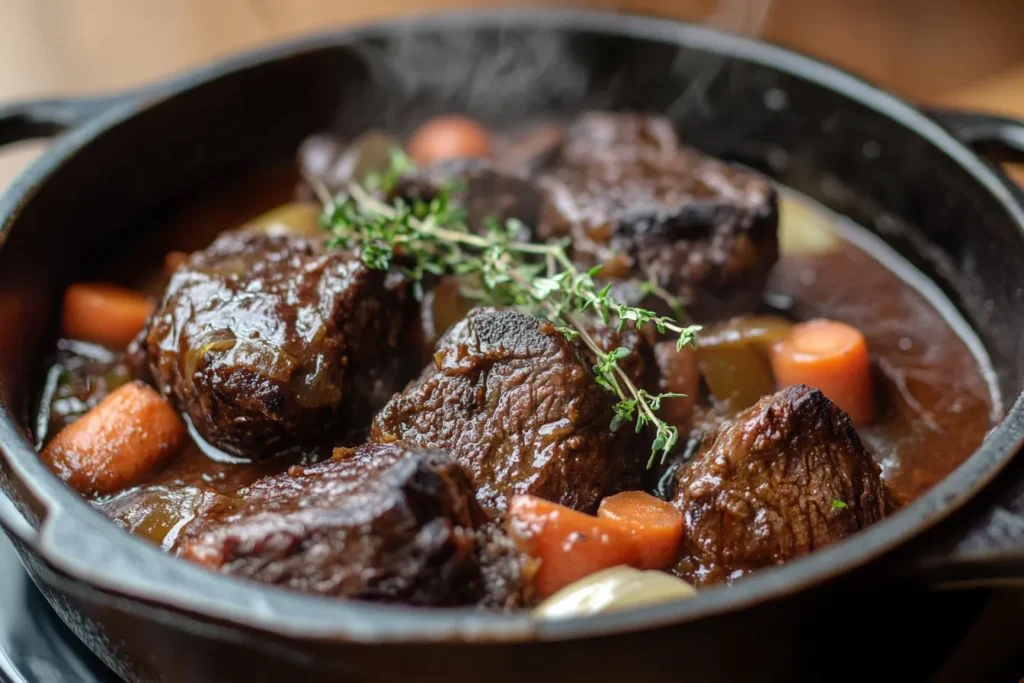
Why Slow Cooking is the Key to Tenderness
Since beef cheeks are packed with connective tissue, they need a long cooking time at a low temperature to break down properly. If you try to cook them too fast, they’ll end up tough and chewy.
Fun Fact: When cooked low and slow, beef cheeks become fall-apart tender, almost like pulled pork but with a richer, beefier taste.
Braising vs. Sous Vide: Which is Better?
Braising and sous vide are two of the most popular ways to cook beef cheeks. Both yield amazing results, but they have some key differences.
| Cooking Method | Pros | Cons |
|---|---|---|
| Braising | Rich, deep flavors; creates its own sauce | Requires a pot and oven; takes 3-4 hours |
| Sous Vide | Perfectly tender results; retains all moisture | Requires a sous vide machine; takes 24+ hours |
If you love bold, rich flavors, go for braising. If you want ultra-precise tenderness and don’t mind waiting, sous vide is the way to go.
Can You Grill or Roast Beef Cheeks?
Technically, yes. But grilling or roasting beef cheeks without pre-cooking them will result in a tough, chewy texture. If you want to grill them, try this:
- Braise First: Slow-cook the beef cheeks in broth for 3-4 hours.
- Cool and Slice: Let them rest, then slice into thick pieces.
- Grill for a Charred Finish: Sear them over high heat for 1-2 minutes per side.
This method gives you the best of both worlds—tender meat with a crispy, smoky crust.
Common Problems When Cooking Beef Cheeks (and How to Fix Them)
Cooking beef cheeks is simple, but there are some common mistakes that can ruin the dish. Here’s how to avoid them.
Tough and Chewy Meat: What Went Wrong?
If your beef cheeks turn out tough, it’s usually because they weren’t cooked long enough. This cut needs at least 3 hours of slow cooking, sometimes more.
Fix: If your meat is still chewy, put it back on low heat and let it cook longer. Patience is key!
Too Much Fat: How to Trim It Properly
Beef cheeks can have a layer of fat and connective tissue. While some fat is good, too much can make the dish greasy.
Fix: Before cooking, trim off any excess fat and remove the tough silver skin using a sharp knife.
Flavor Lacking Depth? The Secret Ingredients to Use
If your beef cheeks taste bland, it’s likely because they weren’t seasoned properly or lacked acidity to balance the richness.
Fix: Boost the flavor with these ingredients:
- Red Wine: Adds richness and depth.
- Tomato Paste: Enhances umami.
- Vinegar or Citrus: Balances the heaviness of the meat.
- Fresh Herbs: Thyme, rosemary, and bay leaves add fragrance.
Now that you know how to cook beef cheeks perfectly, let’s move on to some delicious recipes you can try at home!
Delicious Beef Cheek Recipes to Try
Now that you know how to cook beef cheeks perfectly, it’s time to put that knowledge to use! Here are three must-try recipes that bring out the best in this underrated cut.
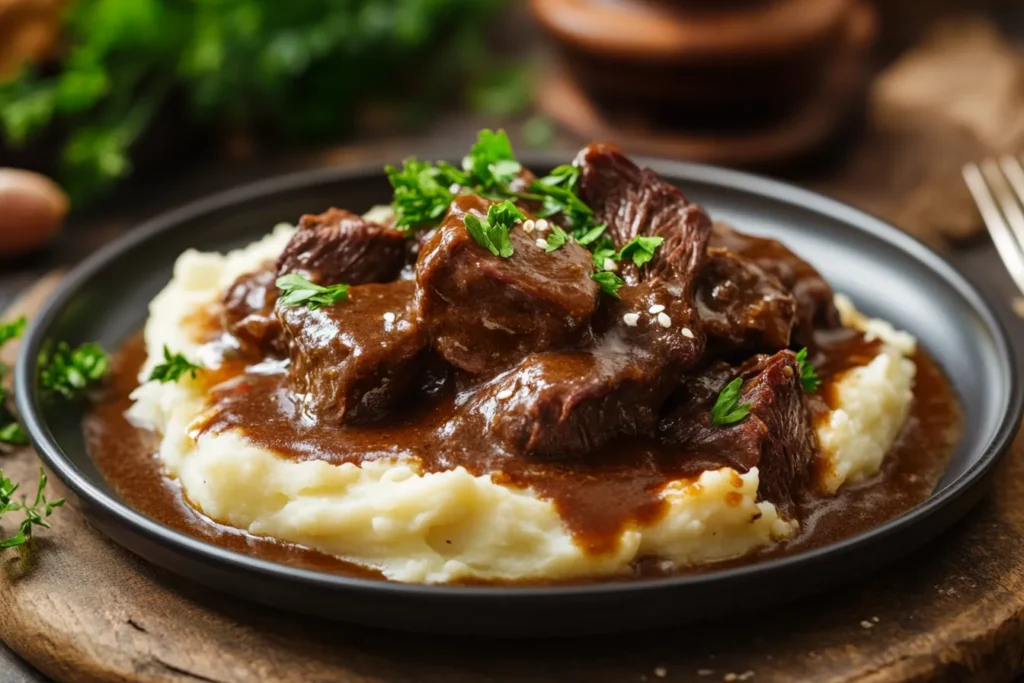
Classic Red Wine Braised Beef Cheeks
This dish is a French-inspired masterpiece, slow-cooked in a rich red wine sauce until the meat is fork-tender.
Ingredients:
| Ingredient | Quantity |
|---|---|
| Beef Cheeks | 2 lbs (900g) |
| Red Wine | 2 cups |
| Beef Broth | 2 cups |
| Onion (chopped) | 1 large |
| Carrots (sliced) | 2 |
| Garlic (minced) | 4 cloves |
| Tomato Paste | 2 tbsp |
| Fresh Thyme & Bay Leaves | To taste |
| Salt & Pepper | To taste |
Instructions:
- Season beef cheeks with salt and pepper, then sear them in a hot pan until browned.
- Remove from the pan and sauté onions, carrots, and garlic until softened.
- Stir in tomato paste, then pour in the red wine, scraping the bottom of the pan.
- Add beef cheeks back to the pot, pour in the beef broth, and add thyme and bay leaves.
- Cover and simmer on low for 3-4 hours until the meat is tender.
- Remove the beef cheeks, strain the sauce, and reduce it to a silky consistency.
- Serve with mashed potatoes or polenta.
Pro Tip: Let the beef cheeks rest in the sauce for an hour before serving for an even deeper flavor.
Mexican-Inspired Barbacoa Beef Cheeks
If you love tacos, this barbacoa-style beef cheek recipe will be your new favorite!
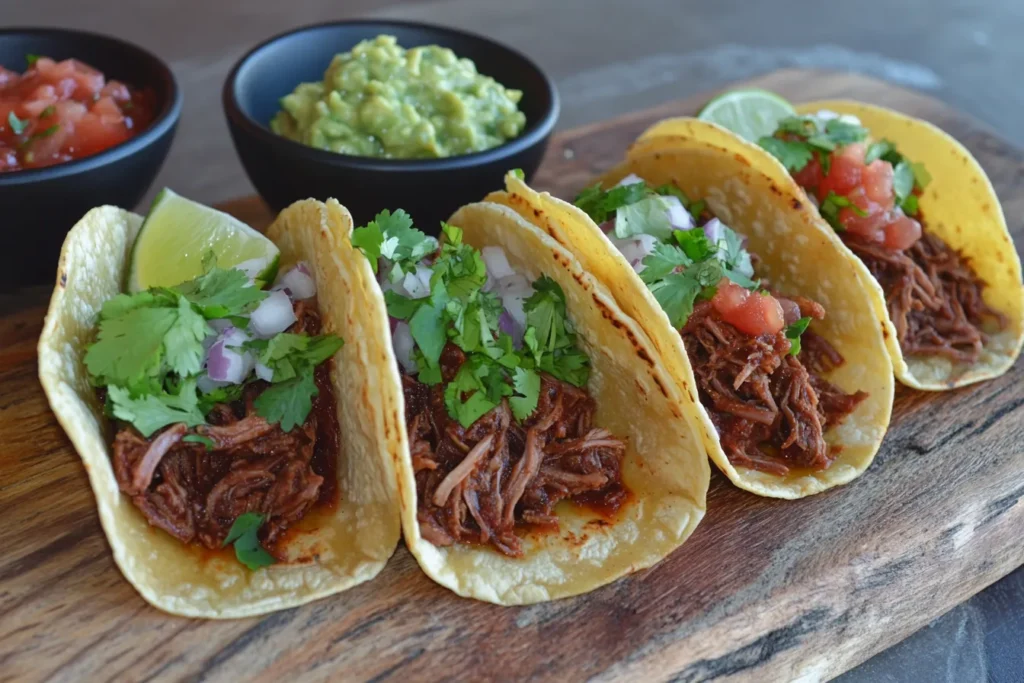
Ingredients:
| Ingredient | Quantity |
|---|---|
| Beef Cheeks | 2 lbs (900g) |
| Chipotle Peppers in Adobo | 2 |
| Beef Broth | 2 cups |
| Garlic (minced) | 3 cloves |
| Onion (chopped) | 1 |
| Cumin & Oregano | 1 tsp each |
| Lime Juice | 1 tbsp |
Instructions:
- Sear beef cheeks in a hot pan until browned.
- Place in a slow cooker with chipotle peppers, garlic, onion, broth, cumin, and oregano.
- Cook on low for 6-8 hours until the meat is fall-apart tender.
- Shred the beef and mix with lime juice.
- Serve in tacos with fresh cilantro, onions, and salsa.
Pro Tip: For extra flavor, let the shredded beef soak in the sauce for 30 minutes before serving.
Slow Cooker Beef Cheeks with Root Vegetables
Looking for an easy, comforting meal? This slow cooker recipe is hands-off and full of flavor.
Ingredients:
| Ingredient | Quantity |
|---|---|
| Beef Cheeks | 2 lbs (900g) |
| Beef Broth | 2 cups |
| Carrots (chopped) | 2 |
| Potatoes (quartered) | 3 |
| Celery (chopped) | 2 stalks |
| Garlic & Onion | To taste |
Instructions:
- Place all ingredients in a slow cooker.
- Cook on low for 8 hours or until the beef cheeks are tender.
- Shred the meat and mix with the vegetables.
- Serve with a ladle of the broth.
Best Side Dishes to Pair with Beef Cheeks
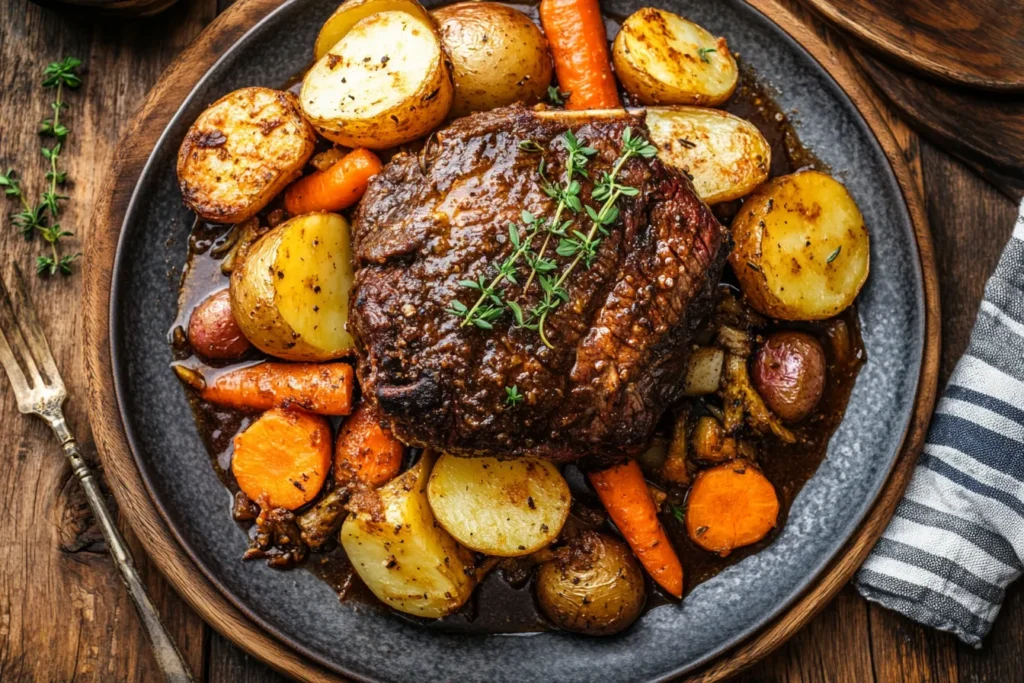
Beef cheeks are rich and flavorful, so they pair well with these side dishes:
- Creamy Mashed Potatoes: The perfect vessel for soaking up that delicious sauce.
- Rustic Polenta or Risotto: Adds a smooth, creamy contrast.
- Roasted Root Vegetables: A hearty, earthy companion to the beef.
- Buttery Garlic Bread: Because you’ll want to mop up every last drop of sauce!
Final Tips for Cooking Perfect Beef Cheeks
Before you head to the kitchen, here are some last-minute tips to ensure your beef cheeks turn out amazing:
- Marinate Overnight: If time allows, marinating the meat adds extra depth.
- Use a Heavy-Duty Pot: A Dutch oven or slow cooker works best for braising.
- Don’t Rush the Process: The longer it cooks, the better it gets!
- Store & Reheat Properly: Beef cheeks taste even better the next day. Store in an airtight container and reheat slowly on the stovetop.
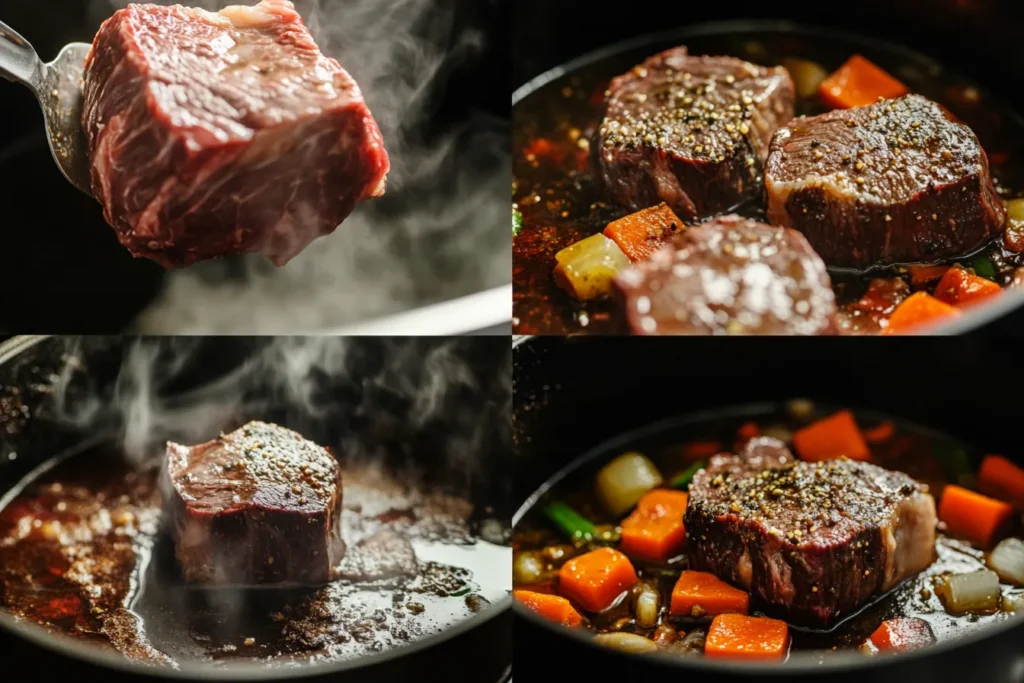
Conclusion: Why You Should Try Beef Cheek Meat
If you haven’t cooked with beef cheeks before, now is the perfect time to start! They’re affordable, packed with flavor, and incredibly tender when prepared right. Whether you’re braising them in red wine, slow-cooking them for tacos, or pairing them with creamy mashed potatoes, beef cheeks are a game-changer.
So, next time you visit the butcher, don’t overlook this hidden gem. Give it a try and impress your friends and family with a restaurant-quality meal at home!

